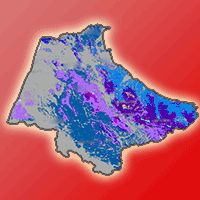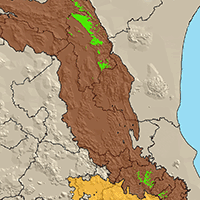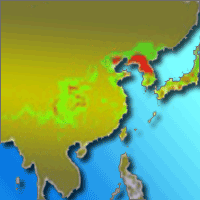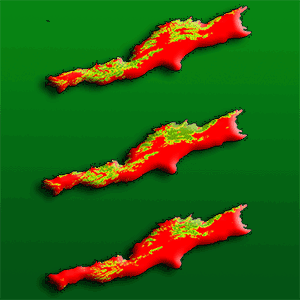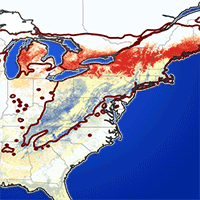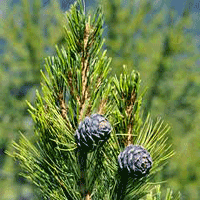The impact of climate change on ecosystems, especially at the species level, can be currently observed in many parts of the world. Species distribution models (SDMs) are widely used to predict the likely changes in the distribution of species in future climate change scenarios. The aim of the present study is to predict the effect of climate change on a valuable threatened tree species Dysoxylum binectariferum in the northeastern part of Bangladesh using the maximum entropy (MaxEnt) model on species’ occurrence data. The future distribution of D. binectariferum was predicted under two scenarios from the IPCC 5th assessment (RCP 4.5, and RCP 8.5) in 2050 and 2070. Model results showed that approximately 32% (2177 km2) of the studied area is currently suitable for this species to grow. However, future predictions obtained by the model projected a complete loss of suitable habitat for D. binectariferum in the studied area by both 2050 and 2070. Therefore, urgent measures are required for the conservation of D. binectariferum in northeastern Bangladesh. The application of species distribution models to simple inventory data (such as the occurrence of the species) may provide policymakers and conservationists with a useful tool for the prediction of future distribution (at both local and regional scales) of poorly known species with high preservation concerns.
Keywords
, , , ,
Citation
Sohel SI, Akhter S, Ullah H, Haque E, Rana P (2016). Predicting impacts of climate change on forest tree species of Bangladesh: evidence from threatened Dysoxylum binectariferum (Roxb.) Hook.f. ex Bedd. (Meliaceae). iForest 10: 154-160. - doi: 10.3832/ifor1608-009
Academic Editor
Rupert Seidl
Paper history
Received: Feb 19, 2015
Accepted: Jan 20, 2016
First online: May 25, 2016
Publication Date: Feb 28, 2017
Publication Time: 4.20 months
© SISEF - The Italian Society of Silviculture and Forest Ecology 2016
Open Access
This article is distributed under the terms of the Creative Commons Attribution-Non Commercial 4.0 International (https://creativecommons.org/licenses/by-nc/4.0/), which permits unrestricted use, distribution, and reproduction in any medium, provided you give appropriate credit to the original author(s) and the source, provide a link to the Creative Commons license, and indicate if changes were made.

Breakdown by View Type
(Waiting for server response...)
Article Usage
Total Article Views: 55298
(from publication date up to now)
Breakdown by View Type
HTML Page Views: 45250
Abstract Page Views: 4299
PDF Downloads: 4291
Citation/Reference Downloads: 43
XML Downloads: 1415
Web Metrics
Days since publication: 3495
Overall contacts: 55298
Avg. contacts per week: 110.75
Article Citations
Article citations are based on data periodically collected from the Clarivate Web of Science web site
(last update: Mar 2025)
Total number of cites (since 2017): 10
Average cites per year: 1.11
Publication Metrics
by Dimensions ©
Articles citing this article
List of the papers citing this article based on CrossRef Cited-by.
(1)
Akhter S, Raihan F, Sohel MSI, Syed MA, Das SK, Alamgir M (2013)Coping with climate change by using indigenous knowledge of ethnic communities from in and around Lawachara National Park of Bangladesh. Journal of Forest Science 29: 181-193.
CrossRef |
Gscholar
(2)
Alamgir M, Mukul SA, Turton SM (2015)Modelling spatial distribution of critically endangered Asian elephant and Hoolock gibbon in Bangladesh forest ecosystems under a changing climate. Applied Geography 60: 10-19.
CrossRef |
Gscholar
(3)
Bakkenes M, Alkemade JMR, Ihle F, Leemans R, Latour JB (2002)Assessing effects of forecasted climate change on the diversity and distribution of European higher plants for 2050. Global Change Biology 8: 390-407.
CrossRef |
Gscholar
(4)
Barrows CW, Rotenberry JT, Allen MF (2010)Assessing sensitivity to climate change and drought variability of a sand dune endemic lizard. Biological Conservation 143: 731-736.
CrossRef |
Gscholar
(5)
Champion HG (1936)A preliminary survey of the forest types of India and Burma. In: “Indian Forest Records (New Series)”. Vol i, no. 1, Government of India Press, New Delhi, India, pp. 286.
Gscholar
(6)
Craig BS (1991)The Capped Langur in Bangladesh: behavioural ecology and reproductive tactics. S Karger publisher, Basel, Switzerland, pp. 180.
Online |
Gscholar
(7)
Dawson TP, Jackson ST, House JI, Prentice IC, Mace GM (2011)Beyond predictions: biodiversity conservation in a changing climate. Science 332: 53-58.
CrossRef |
Gscholar
(8)
Dullinger S, Gattringer A, Thuiller W, Moser D, Zimmermann NE, Guisan A, Willner W, Plutzar C, Leitner M, Mang T, Caccianiga M, Dirnböck T, Ertl S, Fischer A, Lenoir J, Svenning J, Psomas A, Schmatz DR, Silc U, Vittoz P, Hülber K (2012)Extinction debt of high-mountain plants under twenty-first century climate change. Nature Climate Change 2: 619-622.
CrossRef |
Gscholar
(9)
Efron B, Stein C (1981)The jackknife estimate of variance. The Annals of Statistics 9 (3): 586-596.
CrossRef |
Gscholar
(10)
Elith J, Graham CH, Anderson RP, Elith J, Graham CH, Anderson RP, Dudik M, Ferrier S, Guisan A, Hijmans RJ, Huettmann F, Leathwick JR, Lehmann A, Li J, Lohmann LG, Loiselle BA, Manion G, Moritz C, Nakamura M, Nakazawa Y, Overton JMC, Peterson AT, Phillips SJ, Richardson KS, Scachetti-Pereira R, Schapire RE, Soberon J, Williams S, Wisz MS, Zimmermann NE (2006)Novel methods improve prediction of species’ distributions from occurrence data. Ecography 29: 129-151.
CrossRef |
Gscholar
(11)
Elith J, Leathwick JR (2009)Species distribution models: ecological explanation and prediction across space and time. Annual Review of Ecology, Evolution and Systematics 40: 677-697.
CrossRef |
Gscholar
(12)
Feeley KJ, Silman MR (2010)Land-use and climate change effects on population size and extinction risk of Andean plants. Global Change Biology 16: 3215-3222.
CrossRef |
Gscholar
(13)
Franklin J (2009)Mapping species distributions: spatial inference and prediction. Cambridge University Press, Cambridge, UK, pp. 336.
Gscholar
(14)
Gray TNE, Chamnan H, Borey R, Collar NJ, Dolman PM (2007)Habitat preferences of a globally threatened bustard provide support for community based conservation in Cambodia. Biological Conservation 138: 341-350.
CrossRef |
Gscholar
(15)
Guisan A, Thuiller W (2005)Predicting species distribution: offering more than simple habitat models. Ecology Letters 8: 993-1009.
CrossRef |
Gscholar
(16)
Hannah L, Midgley G, Millar D (2002)Climate change-integrated conservation strategies. Global Ecology and Biogeography 11: 485-495.
CrossRef |
Gscholar
(17)
Hijmans RJ, Cameron SE, Parra JL, Jones PG, Jarvis A (2005)Very high resolution interpolated climate surfaces for global land areas. International Journal of Climatology 25: 1965-1978.
CrossRef |
Gscholar
(18)
Jain SK, Meenaa S, Gupta AP, Kushwaha M, Shaanker RU, Jaglan S, Bharate SB, Vishwakarma RA (2014)Dysoxylum binectariferum bark as a new source of anticancer drug camptothecin: bioactivity-guided isolation and LCMS-based quantification. Bioorganic and Medicinal Chemistry Letters 24: 3146-3149.
CrossRef |
Gscholar
(19)
Khan MS, Matiur RM, Arshad AM (2001)Red data book of vascular plants of Bangladesh. Bangladesh National Herbarium, Dhaka, Bangladesh, pp. 179.
Gscholar
(20)
Karjalainen E, Sarjala T, Raitio H (2010)Promoting human health through forests: overview and major challenges. Environmental Health and Preventive Medicine 15: 1-8.
CrossRef |
Gscholar
(21)
Lenoir J, Gegout JC, Marquet PA, Ruffray PD, Brisse H (2008)A significant upward shift in plant species optimum elevation during the 20th century. Science 320: 1768-1771.
CrossRef |
Gscholar
(22)
Meinshausen M, Smith SJ, Calvin K, Daniel JS, Kainuma MLT, Lamarque JF, Matsumoto K, Montzka SA, Raper SCB, Riahi K, Thomson A, Velders GJM, Van Vuuren DPP (2011)The RCP greenhouse gas concentrations and their extensions from 1765 to 2300. Climate Change 109: 213-24.
CrossRef |
Gscholar
(23)
NACOM (2003)Co-management of tropical forest resources of Bangladesh: secondary data collection for pilot protected areas: Lawachara National Park. Nature Conservation Management (NACOM), USAID/Bangladesh and Ministry of Environment and Forest, Government of Bangladesh, Dakha, Bangladesh, pp. 54.
Gscholar
(24)
NSP (2006)Protected areas of Bangladesh: a visitor’s guide. Nishorgo Support Project (NSP), Dhaka, Bangladesh, pp. 41.
Gscholar
(25)
Oliver T, Hill JK, Thomas CD, Brerton T, Roy DB (2009)Change in habitat specificity of species at their climate change range boundaries. Ecology Letters 12: 1091-1102.
CrossRef |
Gscholar
(26)
Parcha V, Gahlot M, Kaur J, Tomar Y (2004)A review on phytochemical and pharmacological studies of
Dysoxylum species. Journal of Natural Remedies 4: 1-11.
Online |
Gscholar
(27)
Parmesan C, Yohe G (2003)A globally coherent fingerprint of climate change impacts across natural systems. Nature 421: 37-42.
CrossRef |
Gscholar
(28)
Peng H, Mabberley DJ (2008)Dysoxylum Blume. Flora of China. Vol. 11 (Oxalidaceae through Aceraceae). Science Press, Beijing, China and Missouri Botanical Garden Press, St. Louis, MO, USA, pp. 50.
Gscholar
(29)
Peterson AT, Shaw J (2003)Lutzomyia vectors for cutaneous leishmaniasis in southern Brazil: ecological niche models, predicted geographic distribution, and climate change effects. International Journal of Parasitology 33: 919-931.
CrossRef |
Gscholar
(30)
Phillips SJ, Anderson RP, Schapire RE (2006)Maximum entropy modeling of species geographic distributions. Ecological Modelling 190: 231-259.
CrossRef |
Gscholar
(31)
Phillips SJ, Dudik M, Elith J, Graham CH, Lehmann A, Leathwick J, Ferrier S (2009)Sample selection bias and presence-only distribution models: implications for background and pseudo-absence data. Ecological Applications 19 (1): 181-197.
CrossRef |
Gscholar
(32)
Riahi K, Gruebler A, Nakicenovic N (2007)Scenarios of long-term socio-economic and environmental development under climate stabilization. Technological Forecasting and Social Change 74 (7): 887-935.
CrossRef |
Gscholar
(33)
Shrestha UB, Bawa KS (2014)Impact of climate change on potential distribution of Chinese caterpillar fungus (
Ophiocordyceps sinensis) in Nepal Himalaya. PLoS ONE 9: 1-11.
CrossRef |
Gscholar
(34)
Sohel MSI, Mukul SA, Burkhard B (2015)Landscape’s capacities to supply ecosystem services in Bangladesh: a mapping assessment for Lawachara National Park. Ecosystem Services 12: 128-135.
CrossRef |
Gscholar
(35)
Sohel MSI, Rana MP, Karim SMF, Akhter S (2010)Linking co-management, livelihood and forest conservation in protected area: a case study of wildlife sanctuary. International Journal of Ecological Economics and Statistics 16: 86-95.
Online |
Gscholar
(36)
Thomas CD, Cameron A, Green RE, Bakkenes M, Beaumont LJ, Collingham YC, Erasmus BF, de Siqueira MF, Grainger A, Hannah L, Hughes L, Huntley B, van Jaarsveld AS, Midgley GF, Miles L, Ortega-Huerta MA, Townsend Peterson A, Phillips OL, Williams SE (2004)Extinction risk from climate change. Nature 427 (6970): 145-148.
CrossRef |
Gscholar
(37)
Trisurat Y, Rajendra P, Shrestha B, Kjelgren R (2011)Plant species vulnerability to climate change in peninsular Thailand. Applied Geography 31: 1106-1114.
CrossRef |
Gscholar
(38)
Welk E, Schubert K, Hoffmann MH (2002)Present and potential distribution of invasive mustard (
Alliara petiolata) in North America. Diversity and Distribution 8: 219-233.
CrossRef |
Gscholar
(39)
Wise MA, Calvin KV, Thomson AM, Clarke LE, Bond-Lamberty B, Sands RD, Smith SJ, Janetos AC, Edmonds JA (2009)Implications of limiting CO
2 concentrations for land use and energy. Science 324: 1183-1186.
CrossRef |
Gscholar
(40)
Wiens JA, Stralberg D, Jongsomjit D, Howell CA, Snyder MA (2009)Niches, models, and climate change: assessing the assumptions and uncertainties. Proceedings of the National Academy of Sciences USA 106: 19729-19736.
CrossRef |
Gscholar
(41)
Yu D, Zhou L, Zhou W, Ding H, Wang Q, Wang Y, Wu X, Dai L (2011)Forest management in northeast China: history, problems, and challenges. Environmental Management 48: 1122-1135.
CrossRef |
Gscholar


